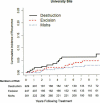Tumor recurrence 5 years after treatment of cutaneous basal cell carcinoma and squamous cell carcinoma
- PMID: 23190903
- PMCID: PMC3711403
- DOI: 10.1038/jid.2012.403
Tumor recurrence 5 years after treatment of cutaneous basal cell carcinoma and squamous cell carcinoma
Abstract
For most cutaneous basal cell and squamous cell carcinomas (nonmelanoma skin cancers (NMSCs)), data are insufficient to permit evidence-based choices among treatments. To compare tumor recurrence after treatments, we conducted a prospective cohort study of consecutive patients with primary NMSCs treated with the most common treatments, in two practices in 1999-2000. Recurrence was determined from medical records by observers blinded to treatment type. Follow-up was available for 1,174 patients with 1,488 tumors (93.8%) at median 7.4 years; of these tumors, 24.3% (N=361) were treated with destruction with electrodessication/curettage, 38.3% (N=571) with excision, and 37.4% (N=556) with histologically guided serial excision (Mohs surgery). The overall 5-year tumor recurrence rate (95% confidence interval) was 3.3% (2.3, 4.4). Unadjusted recurrence rates did not differ after treatments: 4.9% (2.3, 7.4) after destruction, 3.5% (1.8, 5.2) after excision, and 2.1% (0.6, 3.5) after Mohs surgery (P=0.26), and no difference was seen after adjustment for risk factors. In tumors treated only with excision or Mohs surgery, the hazard of recurrence was not significantly different, even after adjustment for propensity for treatment with Mohs surgery. These data indicate that common treatments for NMSCs were at least 95% effective, and further studies are needed to guide therapeutic choices for different clinical subgroups.
Figures




Comment in
-
Cost effectiveness of Mohs micrographic surgery.J Invest Dermatol. 2013 May;133(5):1129-31. doi: 10.1038/jid.2012.473. J Invest Dermatol. 2013. PMID: 23594532
-
Properly selected skin cancer treatments are very effective.J Invest Dermatol. 2014 Apr;134(4):1133-1135. doi: 10.1038/jid.2013.449. Epub 2013 Nov 12. J Invest Dermatol. 2014. PMID: 24217010 No abstract available.
-
Response to Rogers et al.J Invest Dermatol. 2014 Apr;134(4):1135-1136. doi: 10.1038/jid.2013.450. Epub 2013 Nov 12. J Invest Dermatol. 2014. PMID: 24217013 Free PMC article. No abstract available.
References
-
- Charlson ME, Pompei PP, Ales KL, et al. A new method of classifying prognostic comorbidity in longitudinal studies: development and validation. J Chron Dis. 1987;40:373–83. - PubMed
-
- Chren MM, Sahay AP, Sands LP, et al. Variation in care for nonmelanoma skin cancer in a private practice and a Veterans Affairs clinic. Med Care. 2004;42:1019–26. - PubMed
-
- Chren MM, Sahay AP, Bertenthal DS, et al. Quality-of-life outcomes of treatments for cutaneous basal cell carcinoma and squamous cell carcinoma. J Invest Dermatol. 2007;127:1351–7. - PubMed
-
- Chren MM, Sahay AP, Sands LP, et al. Variation in care for nonmelanoma skin cancer in a private practice and a veterans affairs clinic. Med Care. 2004;42:1019–26. - PubMed
Publication types
MeSH terms
Grants and funding
LinkOut - more resources
Full Text Sources
Other Literature Sources
Medical

